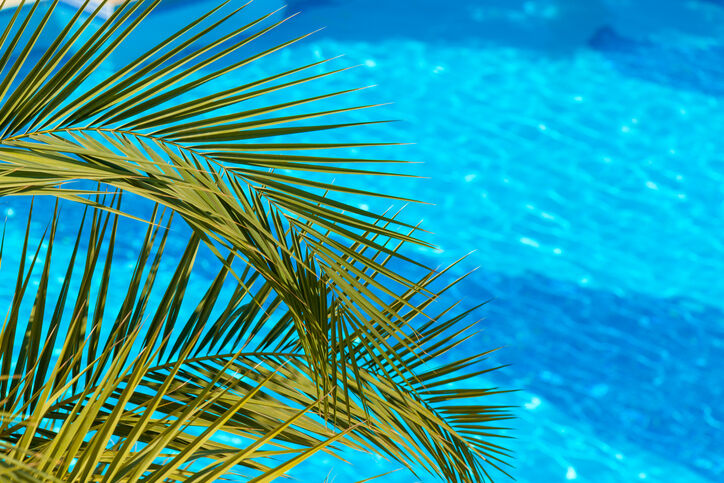Tucson has a lot of pools — nearly 37,000 according to the City of Tucson. They’re a great escape from the heat of the summer, and can feel like an oasis in the desert. They are a lot of maintenance, however, and one way you can reduce your pool maintenance is to make sure you have the appropriate plants in your pool area. There are three main considerations when choosing plants for a pool area.
1. Litter. Some plants are simply messier than others. For example, the colorful bracts of bougainvillea tend to dry to papery leaves and blow everywhere. Mesquites drop their tiny leaves in winter, but also shed a lot of pollen in spring and then follow that with dropping their seed pods. Any deciduous tree will end up dropping leaf litter in the fall. All this plant debris can clog up your pool machinery, and increase your pool deck maintenance.
2. Thorns and spikes. Avoid having plants in the pool area that are thorny, particularly near the pool deck. Keep the areas around your pool equipment and storage clear of spiky plants, too. Nobody wants to be dodging those in their shorts or bathing suit! Native trees like palo blanco (Acacia willardiana), palo brea (Cercidium praecox), ironwood (Olneya tesota), and kidneywood (Eysenhardtia orthocarpa) have no thorns and are low-litter and drought-tolerant once established.
3. Plant size. For example, some people will want to shade their pool and deck area, while others want to have sun on the pool in order to warm the water. When choosing trees for your pool area, consider which of these options work for you, and then think about the height of the tree you choose. Palm trees are relatively low-litter and are a good choice for the pool. If you plant tall ones on the south or west side of your pool be ready for the shade they will provide. Most palm trees are relatively low maintenance, and species such as the California fan palm (Washingtonia filifera) and Mexican blue palm (Brahea armata) don’t use a lot of water. In addition, keep in mind the final size of any bushes or succulents you plant, and make sure they will not interfere with areas where people want to sit or walk.
For those allergic to bee stings, a final consideration is flowering plants. You will likely want to avoid flowering plants at ground level if anyone in your household has a life-threatening reaction to bee stings. You don’t need to exclude flowers if you have a normal reaction; solitary bees (the vast majority of the bees that will visit your plants) are very docile and won’t sting unless severely provoked. Native solitary bees do not become africanized. Africanized bees are a hybrid between European honeybees and African bees, and were originally bred in Brazil. They are much more aggressive than non-hybridized European honeybees. Honeybees are very different from native solitary bees; they live in large colonies and are used by humans for production of honey and pollination services for agricultural crops. Honeybees are very unusual in the bee world —there are only seven species of honeybees worldwide (of which two are domesticated), while Arizona alone has 1,300 species of native solitary bees.
There are many plants that work well for pool areas and tend to grow well in our climate. The Arizona Municipal Water Users Association has a searchable online catalog of plants that include pool-friendly selections although some of their choices are too thorny or spiky for my liking. You can further narrow your search by plant type, size, water use, sun requirement, and other helpful characteristics.
The University of Arizona’s Extension office also has a list of plants for poolside areas.





